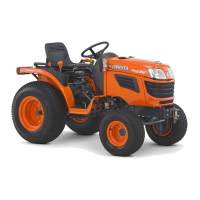Why is my Kubota B1620 engine difficult to start?

Why is my Kubota B1620 engine difficult to start?
| Engine Type | Diesel |
|---|---|
| Cylinders | 3 |
| Fuel Type | Diesel |
| Hydraulic System Type | Open center |
| Drive | 4WD |
| 3-Point Hitch Category | Category I |
Comprehensive table of technical specifications for different models.
Details on tractor traveling speeds based on gears and conditions.
Essential checks and precautions before starting tractor operation.
Information on operator protection structures like CAB and ROPS.
Guidelines for operating the tractor safely.
Precautions to ensure children's safety around the tractor.
Specific safety measures and techniques for operating on slopes.
Guidelines for safe road operation, including braking and turning.
Procedures for safely parking the tractor.
Instructions for operating the Power Take-Off (PTO) system safely.
Guidelines for using the 3-point hitch with implements.
Daily inspection procedures to ensure safe operation before starting.
Step-by-step instructions for safely starting the tractor's engine.
Procedures for warming up the engine and transmission fluid.
Guidelines for safely jump-starting the tractor's battery.
Precautions and procedures for operating a new tractor.
Safe practices for mounting and dismounting the tractor.
Instructions for folding and unfolding the Roll Over Protective Structure.
Guide to adjusting the operator's seat for comfort and safety.
Operation of lights, signals, horn, clutch, travel speed, and brakes.
Information regarding the tractor's warranty coverage.
Procedures for safely decommissioning and disposing of the tractor.
Identification and function of dashboard instruments, switches, and controls.
Identification and function of various foot and hand operated controls.
Label showing the layout and function of the tractor's pedals.
Steps for attaching implements to the 3-point hitch.
Information and usage of drawbar and front hitch attachments.
How to operate the 3-point hitch control system.
Information on auxiliary hydraulic connections.
Information on tire types and inflation pressure.
Adjusting wheel tread for stability and tire clearance.
Information on adding ballast for stability and traction.
Schedule of maintenance tasks based on operating hours.
Recommended lubricants, fuel, and coolant specifications.
Steps for opening the tractor's hood for access.
Daily inspection procedures to ensure safe operation before starting.
Maintenance for greasing, engine start, fluid changes, filter replacements, and adjustments.
Fuel system bleeding, fuse replacement, and light bulb replacement.
Common engine problems and their corrective measures.
Maximum permissible masses for the tractor and trailers.
Specifications for trailer load capacities based on tire combinations.